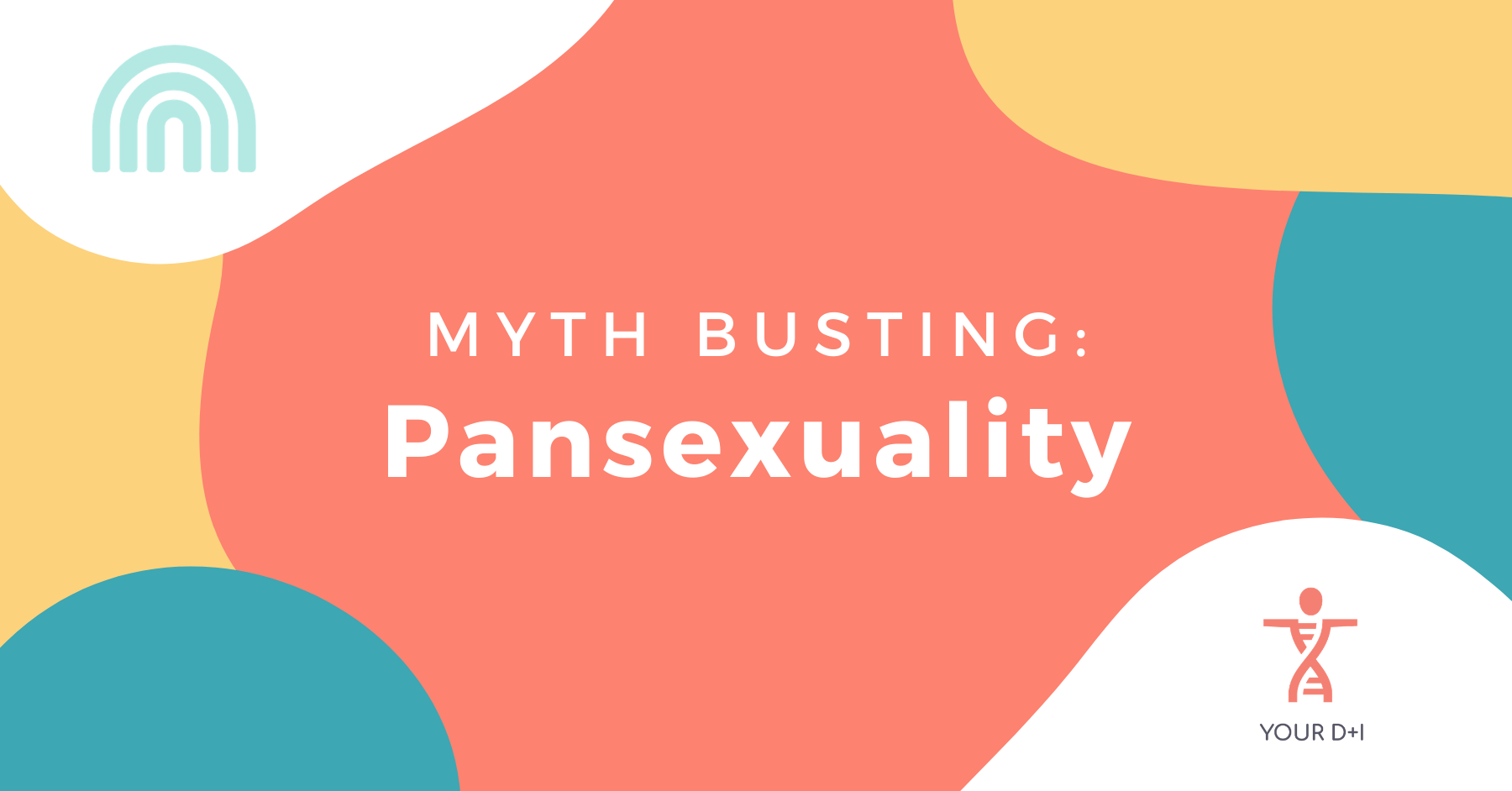Myth Busting: Pansexuality
Happy Pansexual and Panromantic Awareness Day from the Your D+I team! We’re helping spread awareness with a brand new blog post all about pansexuality. Today’s blog continues our Myth Busting: LGBT+ blog series that busts any misconceptions you may have about LGBT+ terms. As usual, we’ll start by clearly defining the topic, pansexuality, and then go into a few common pansexual myths. For each fallacy, we’ll explore why it might exist and, of course, why it isn’t true.
However, there is lots of overlap between bisexual and pansexual myths due to the similarity of the two identities. For example, those who identify as either might encounter stereotypes of infidelity and indecisiveness. As we’ve already covered these misconceptions in Myth Busting: Bisexuality, this post will cover myths exclusive to pansexuality. If you’re wondering where a certain pansexual myth you’ve encountered is, check out our post on bisexuality as it might just be in there.
What is pansexuality?
If a person is pansexual, they are attracted to people of all genders. This means they are attracted to men, women, those who identify as non-binary (outside of the definitions of man or woman) and anyone else.
One way that some pansexuals describe their sexuality is being ‘gender-blind’. This means that when it comes to attraction, pansexuals do not consider the gender of the people they may be attracted to. Being a certain gender isn’t a requirement for pansexuals to be attracted to someone like it can be with other sexualities.
Now, let’s explore some myths about pansexuality…
‘Pansexual is the same as bisexual’
Understandably, one of the most common misconceptions around pansexuality is that it’s just another word for bisexuality. This myth largely comes from the fact that these two sexualities are indeed very similar. While it isn’t the case for all bisexuals, many do experience attraction to all genders – just like pansexuals.
One distinction between the two sexualities, however, is that bisexuals are not all attracted to all genders. Some people who identify as bisexual are only attracted to two genders, whether that be men and women or a combination of their own gender and non-binary people, for example. On the other hand, all pansexuals are attracted to all genders.
Another difference between bisexuality and pansexuality is the concept of being ‘gender-blind’. This means that while some bisexuals might be attracted to different genders in different ways, most pansexuals are not. And while some bisexuals are also attracted to all genders, using the pansexual label makes your attraction to any gender explicit without need for explanation.
‘Only pansexuals are attracted to non-binary people’
The idea that only pansexuals can be attracted to non-binary people is one of the biggest and most contentious pansexual myths out there. This is because it concerns the very definitions of both pansexuality and bisexuality.
One reason for this myth is the words pansexual and bisexual themselves. ‘Pan’, the prefix used in the word pansexual, is Latin for ‘all’. And ‘bi’, the prefix used in the word bisexual, indicates ‘two’ in Latin. This leads many people to believe that bisexuality is more limited and even exclusionary compared to pansexuality. However, the Latin origin of words is rarely an accurate representation of their modern definitions as language, by nature, changes.
Those who believe that bisexuals cannot be attracted to non-binary people understand bisexuality as attraction to only two genders (men and women). However, most people define bisexuality as attraction to two or more genders, one of which usually being your own.
In addition, many gay and straight can people feel attraction to non-binary people. This is especially true if a non-binary person express their gender similarly to the people someone is usually attracted to. However, because this occurrence is rare or just because of a personal preference, they may continue to identify as gay or straight instead of bi.
‘Pansexual and panromantic is all the same’
Another common pansexual myth is the confusion around panromanticism. For many hearing these terms for the first time, their definitions may sound very similar. After all, they are both about being attracted to all genders.
However, the key difference between these identities – and between any identities that end in ‘sexual’ and ‘romantic’ – is the type of attraction they refer to. Pansexuals experience sexual attraction towards all genders, and panromantics experience romantic attraction towards all genders. Now that isn’t to say that pansexuals don’t experience romantic attraction – in fact, most pansexuals are panromantic too. However, a person can be panromantic and have sexual attraction only towards specific (or no) genders.
‘Pansexuals are attracted to cooking equipment’
This myth is a little less serious than the others, but it’s something pansexuals hear all the time. ‘So you fall in love with pots and pans?’ ‘Do you only do it in the kitchen?’ If you don’t take yourself too seriously, you might not mind these jokes. However, when you come out, being ambushed with kitchen-related jokes instead of supporting words can get old.
Even if your sexuality can sound a little funny to some people, it should still be taken seriously. And as pansexuals already have to deal with people not believing their sexuality is real, hearing silly jokes can make this even worse. In fact, the innocent jokes about pots and pans can evolve into hate speech about minority sexualities and genders.
Joking that you are attracted to inanimate objects is disrespectful both to pansexual and non-binary people. This is because these jokes indirectly – and sometimes even directly – compare non-binary people to random objects or animals. ‘If you’re genderfluid, then I’m a cat!’ ‘If you sometimes wake up and feel like a woman, I think I’ll wake up as an umbrella tomorrow!’
These jokes are not okay and are one of the main reason this pansexual myth needs to end. Tackling language, especially when it is seen as banter, is tricky. However, our It’s Just Banter workshop can help your team understand the impact of these kinds of jokes and how to put a stop to them.
‘Pansexuals fancy everyone they meet’
Another misconception about pansexual people is that because they are attracted to all genders, this means they are attracted to all people. Like the previous myth, this one is often said as a joke. However, that doesn’t mean it isn’t hurtful and that all people spreading this myth don’t believe it.
This myth is perpetuated in an experience many LGBT+ have after coming out. After a pansexual person comes out, they are often asked by friends whether they are attracted to them – just because they now know it is possible. This may sound like a harmless question. However, when you ask an LGBT+ person this, you’re telling them you see them as predatory. It also means they’re less likely to feel safe sharing things like this with you again.
At the end of the day, pansexuals are simply not attracted to everyone. Just like those attracted only to women are not attracted to all women, and just like those attracted only to men are not attracted to all men.
Bust these pansexual myths!
Now that you have hopefully learned something new about pansexuality, it’s your turn! Be a good ally to the pansexuals and panromantics out there by busting these myths whenever you hear them. Remember that even pansexual myths that take the form of misinformed jokes can be very harmful to the community.
If you want to improve your team’s awareness of different LGBT+ identities and terminology, check out our workshop The A-to-T of LGBT+. This training course, which is available online or in person, guides you through the ‘ABC’s of LGBT+ terminology!


